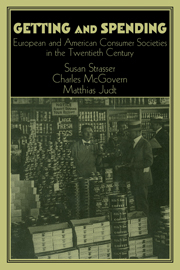Book contents
- Frontmatter
- Introduction
- Part One Politics, Markets, and the State
- Part Two Everyday Life
- 9 World War I and the Creation of Desire for Automobiles in Germany
- 10 Gender, Generation, and Consumption in the United States: Working-Class Families in the Interwar Period
- 11 Comparing Apples and Oranges: Housewives and the Politics of Consumption in Interwar Germany
- 12 “The Convenience Is Out of This World”: The Garbage Disposer and American Consumer Culture
- 13 Consumer Culture in the GDR, or How the Struggle for Antimodernity Was Lost on the Battleground of Consumer Culture
- 14 Changes in Consumption as Social Practice in West Germany During the 1950s
- 15 Reshaping Shopping Environments: The Competition Between the City of Boston and Its Suburbs
- 16 Toys, Socialization, and the Commodification of Play
- 17 The “Syndrome of the 1950s” in Switzerland: Cheap Energy, Mass Consumption, and the Environment
- 18 Reflecting on Ethnic Imagery in the Landscape of Commerce, 1945-1975
- Part Three History and Theory
- Index
18 - Reflecting on Ethnic Imagery in the Landscape of Commerce, 1945-1975
Published online by Cambridge University Press: 05 January 2013
- Frontmatter
- Introduction
- Part One Politics, Markets, and the State
- Part Two Everyday Life
- 9 World War I and the Creation of Desire for Automobiles in Germany
- 10 Gender, Generation, and Consumption in the United States: Working-Class Families in the Interwar Period
- 11 Comparing Apples and Oranges: Housewives and the Politics of Consumption in Interwar Germany
- 12 “The Convenience Is Out of This World”: The Garbage Disposer and American Consumer Culture
- 13 Consumer Culture in the GDR, or How the Struggle for Antimodernity Was Lost on the Battleground of Consumer Culture
- 14 Changes in Consumption as Social Practice in West Germany During the 1950s
- 15 Reshaping Shopping Environments: The Competition Between the City of Boston and Its Suburbs
- 16 Toys, Socialization, and the Commodification of Play
- 17 The “Syndrome of the 1950s” in Switzerland: Cheap Energy, Mass Consumption, and the Environment
- 18 Reflecting on Ethnic Imagery in the Landscape of Commerce, 1945-1975
- Part Three History and Theory
- Index
Summary
Between 1945 and 1975, Americans turned their nation into a global powerhouse of production and consumption, and their government bound together foreign policy success, consumerism, and domestic tranquillity in new and explicit ways. During World War II, the Office of War Information - in posters, billboards, pamphlets, and radio programs - had clearly linked the wartime sacrifices to the coming prosperity of the postwar years. The long-term effects of the G.I. Bills supporting veteran's education, home ownership, and business aspirations trickled down even to Afro-Americans and Mexican Americans. By the early 1960s, many working-class Americans could own television sets, washing machines, and perhaps a Chevy or a Ford. During the Eisenhower presidency, growing consumerism at home was explicitly tied to the fight against communism abroad. At a joint trade fair in Moscow in 1959, Vice President Richard M. Nixon predicted to Soviet Premier Nikita Khrushchev that America would win the fight against communism with its refrigerators, toasters, and cars.2 Prosperity and world hegemony were integrally connected in the postwar world.
Yet the same nation that was shown proceeding toward consumerist heaven in countless television commercials, Hollywood movies, and print advertisements was also riven by profound internal conflict, especially over questions of race and ethnicity. It was only the threat of a massive march on Washington that forced President Franklin D. Roosevelt to issue Executive Order 8802, which established the Fair Employment Practices Commission (FEPC) to investigate charges of discrimination in hiring by government and business. In 1948 the threat of a close presidential election forced President Harry S. Truman to issue Executive Order 9981 to desegregate the armed forces. The National Association for the Advancement of Colored People (NAACP) had agitated for just such actions for over a generation, and after World War II, its work began to pay off. From the late 1940s through the late 1950s, under Chief Justice Earl Warren, the Supreme Court issued a series of decisions that decreed desegregation in party primaries, public transportation, accommodations, and eventually education, most famously in the 1954 landmark decision Brown v. The Board of Education of Topeka, Kansas, which mandated desegregation in American public schools “with all deliberate speed.”
- Type
- Chapter
- Information
- Getting and SpendingEuropean and American Consumer Societies in the Twentieth Century, pp. 379 - 406Publisher: Cambridge University PressPrint publication year: 1998
- 11
- Cited by



